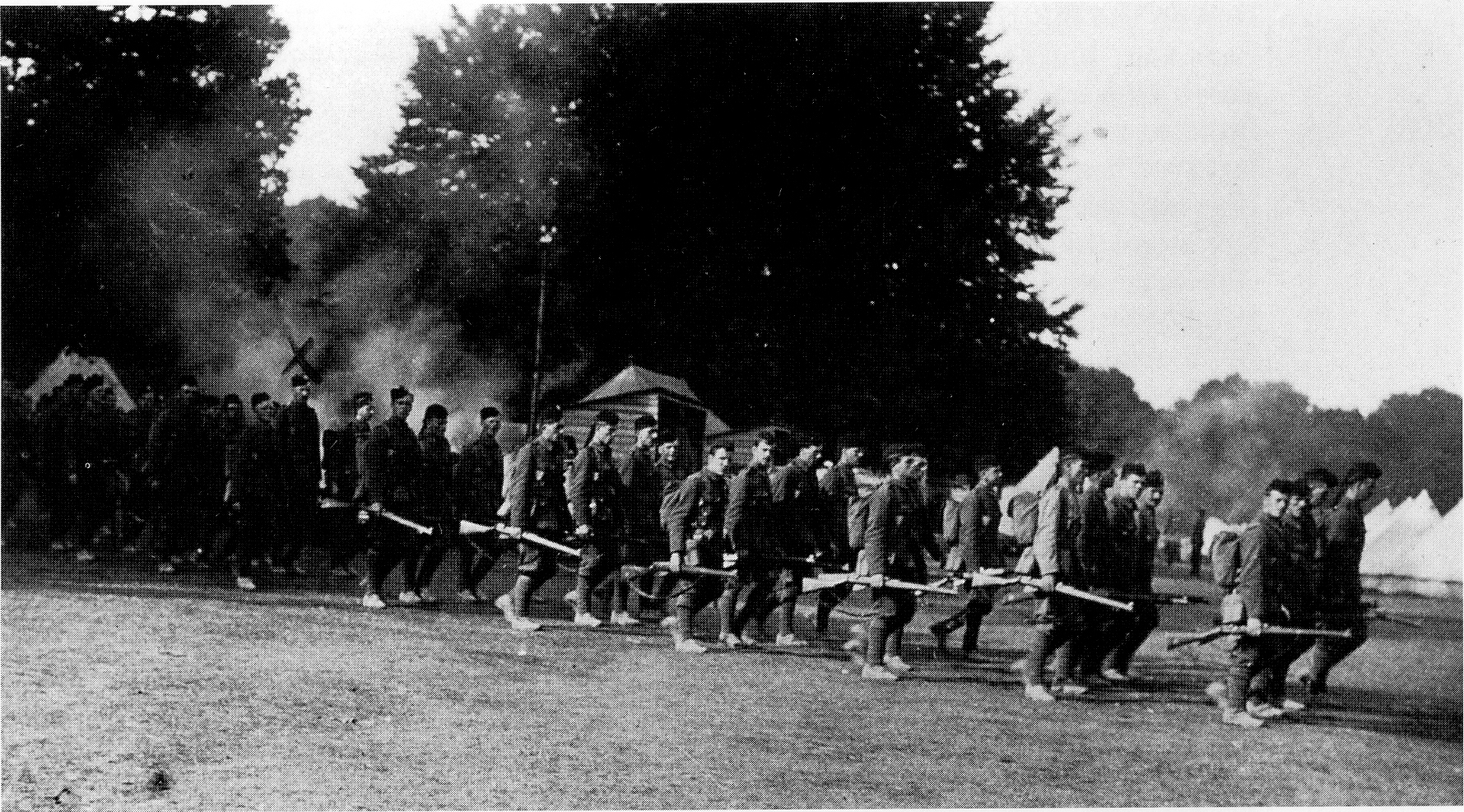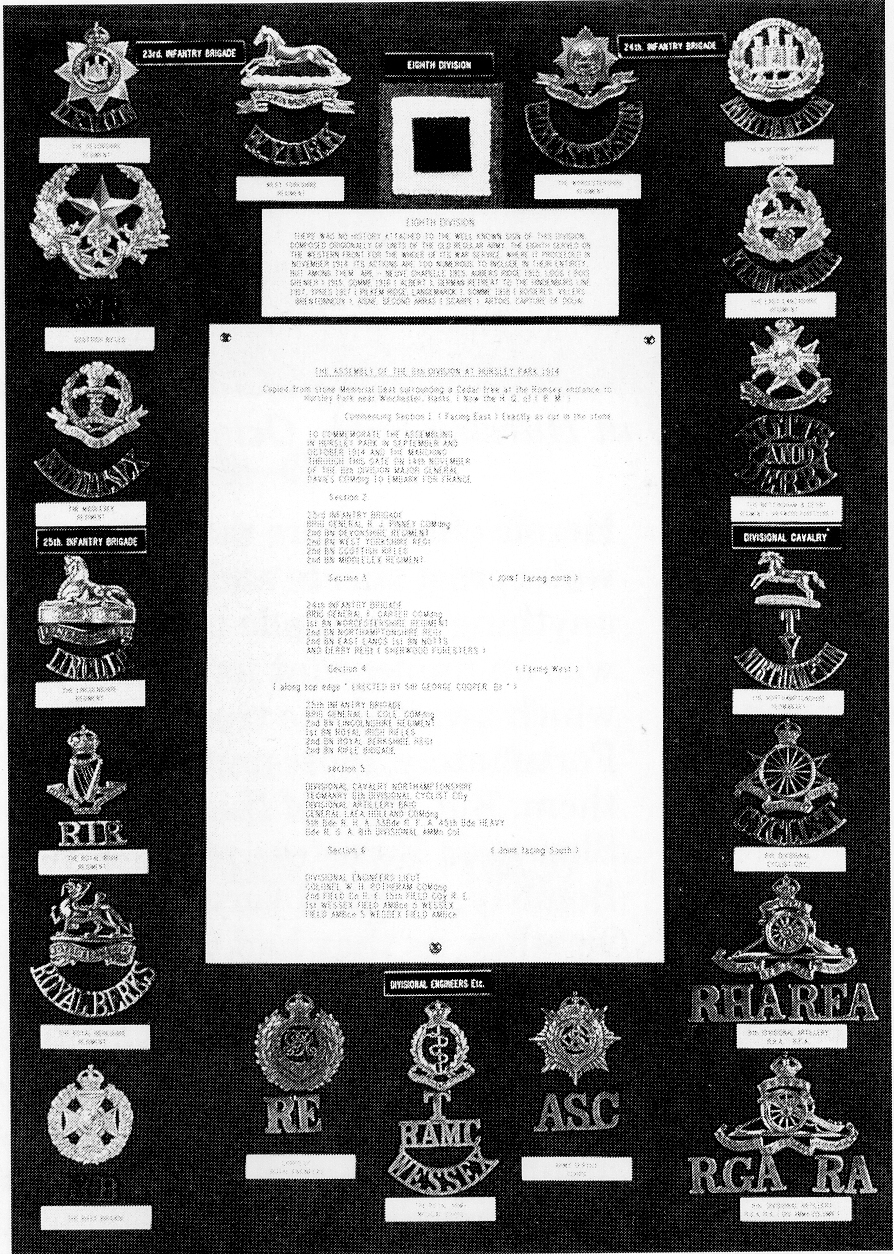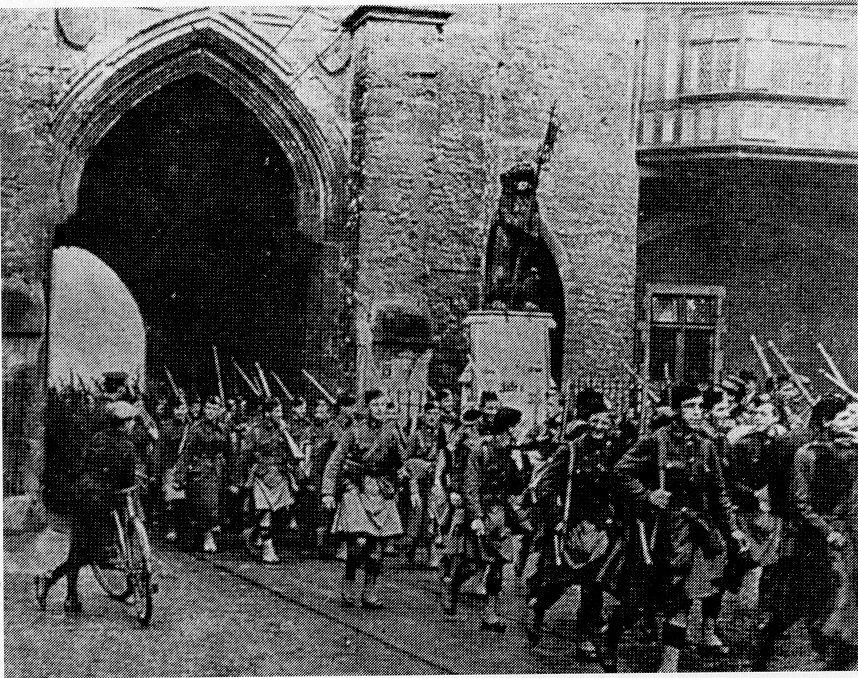The 8th Division
The urgency of the need for the 8th Division was highlighted by the disastrous events that had overtaken the 7th Division in France with a casualty rate of nearly 80 percent. The 8th Division had not existed before the war, and was the second of the improvised formations added to the original British Expeditionary Force. It was composed of troops drawn from overseas garrisons, and consisted of infantry, artillery, and service groups. The composition of these three groups is shown in the diagram.
INFANTRY ARTILLERY MOUNTED TROOPS BRIGADES BATTALIONS BRIGADES EfllfifiDE HEAVY ARTILLERY 2nd Devonshire 1st Northants COLUMN 2nd West Yorks’ Yeomanry fl 23rd 2nd Scots Rifles (Cameronians) 51h RHA 5th Royal 81h 2nd Middlesex i 8th Cyclist Horse lst Worcestershire Company Amllery 2nd East Lancashire 24th 151 Notts and Derby 33rd RFA 33rd 118th (Sherwood Foresters) MOBILE 2nd Northamptonshlre VETERINARY 2nd Lincolnshire SECTION 45th RFA 45”] 119th 2nd Royal Berskshire 25th 1st Royal Irish Rifles 15m Heavy Battery 2nd Rille Brigade Ammn. Columns DIVISIONAL FIELD DIVISIONAL DIVISIONAL FIELD AMMN. COMPAN Y SIGNAL TRANSPORT & AMBULANCES 35A; COLUMN (ENGINEERS) COMPANY COMPANIES Fieild Artillery 2nd 4151 24th (lst Wessex) _ 81h 8th 84th 25m (2nd Wessex) 22 15th 22m 26th (3rd Wessex) Horse Artillery
Composition of the 8th Division November 1914
The twelve infantry battalions were all brought back from overseas stations. One each came from Aden, Bermuda and South Africa, and three each from Egypt, India and Malta. The climatic changes that these moves entailed certainly affected the initial potential of the 8th Division. The mounted troops included an existing yeomanry regiment, and a cyclist company that was formed on mobilisation. The field artillery was made up of one horse artillery brigade (three batteries), the heavy batteries were new units formed at Woolwich, and the field companies came from Cairo in Egypt and Gibraltar.
The 8th Division started to assemble on Baddesley Common but on 2nd October 1914 the Divisional Headquarters and available units moved to Hursley Park, where concentration was effected. The first units to arrive came from Malta, and the arrival of the 2nd East Lancashire Regiment on 30 October 1914 completed the Division, making a total of approximately 12,000 men. All these were accommodated under canvas on the pasture land between Merdon Castle and Hursley House, which must have been a spectacular sight.
Because the surrounding countryside was alive with game, a few well thrown stones or ‘accidental’ rifle shots caused many game birds, rabbits and hares to find their way into the army’s cooking pots. For the first three weeks in the Park the Division had fine weather in which to organise itself, but towards the end of October the fine weather broke and the camp became a sea of mud.
 2nd Scottish Rifles returning from a field day in Hursley Park, October 1914
2nd Scottish Rifles returning from a field day in Hursley Park, October 1914
Heroic efforts were made to ladle the mud into waterproof sheets and remove it, but this, if anything, only made matters worse. The mud was an unpleasant foretaste of the conditions which awaited the troops in France. Fortunately, most units had their kit with them. But some of the troops, like the Sherwood Foresters who had just come from Bombay, suffered very much from the weather, as they had to live in their foreign service khaki drill for over three weeks, no service dress being readily available. November 1914 was in 1994 the wettest this century by almost 20 percent. As already mentioned, the acclimatisation necessary for the overseas troops caused marching qualities to fall below those of a home service battalion.
During the 8th Division’s stay in Hursley Park they had two notable visitors, Sir Henry Rawlinson and Lord Kitchener. Sir Henry Rawlinson came over from France and lectured the whole Division on the troubles that had overtaken the 7th Division. That Division had landed at Zeebrugge and Oostende, and had suffered severely before it joined up with the remainder of the British Army around Ypres. (Out of 400 officers, 840 had become casualties.) Although the troops had gone to the lecture feeling cheerful, they came away feeling as if they had had a good thrashing, and that they apparently had no chance of success over the Germans. Whether this sombre address and its associated depression was the reason for one suicide is a matter of conjecture, but many months after the 8th Division had left Hursley, an Army uniformed corpse was found hanging in Brooks Copse behind Ladwell.
 8th Division cap and shoulder badges
8th Division cap and shoulder badges
Lord Kitchener, the Secretary of State for War, and previously an officer in the Royal Engineers, came and inspected the three companies of Royal Engineers, and almost certainly inspected the whole Division.
In addition to lectures and inspections, the Division practised in artillery and infantry formations with all services in attendance, punctuated by trench digging and rifle practice with the new Lee—Enfield short service rifle. Nearly all the officers and men were given a welcome two days leave.
 Soldiers on horseback in Hursley village
Soldiers on horseback in Hursley village
As a Division, the 8th had some major shortcomings. For artillery it had an ‘unallotted’ brigade of Royal Horse Artillery, and two companies of Royal Field Artillery. It had no field howitzers and no 60-pounders, a deficiency rather inadequately compensated for by two heavy batteries hastily formed at Woolwich and armed with antiquated 4.7-inch guns. Its engineers came from Egypt (2nd Field Company) and Gibraltar (15th Field Company) but its Signal and Cyclist Companies and most of its other divisional units had to be improvised. The division therefore lacked the cohesion that the original six divisions had acquired from working together in peace time. The Divisional Commander, Major-General Francis Davies, came from the War Office, and neither he nor his brigadiers knew the troops placed under their command. The 2nd Devons had expected to be allotted to the same brigade as the other two battalions from Egypt, and were particularly sorry not to be with the 1st Worcestershires with whom they were on the friendliest terms. There was a fair amount of disappointment over many of the placings, but discipline and work was such that there was little time to consider what might have been. On 5 November at noon the 8th Division marched out of the mud 0f Hursley Park in torrents of rain for Southampton Docks. The column’s length was such that when the head of the column reached the Docks, there were still troops getting into marching formation in Hursley Park. Through the streets of Southampton the long column was watched and cheered by large crowds. The column’s length was added to by numerous wagons of two, four and six wheels, guns pulled by horses, and a certain amount of mechanical transport from the Service Corps. Steam and petrol-engined lorries, some with trailers, moved a vast amount of equipment.
 Sottsh Rflies assing through Bar Gate,
Southampton, November 1914
Sottsh Rflies assing through Bar Gate,
Southampton, November 1914
Generally the 8th Division’s stay in Hursley Park had been very uncomfortable in the rain and mud. Special Reservists, sent to bring the 2nd Battalion East Lancashire Regiment up to war requirements, had been somewhat troublesome, so few were sorry to say good-bye to Hursley Camp.
The 8th Division served on the Western Front for the whole of its war service. Its actions are too numerous to include in their entirety, but among them are Neuve Chapelle, Aubers Ridge and Loos (Bois Grenier) in 1915. In 1916 they were at the Somme (Albert), and in 1917 they saw the Germans retreat to the Hindenburg Line, and fought them at Ypres (Pilkem Ridge and Langemarck). Leading up to the end of the war in 1918, they were at the Somme (Rosieres, Villers and Brentonneux), Aisne, Second Arras (Scarpe), and at Artois the capture of Douai.